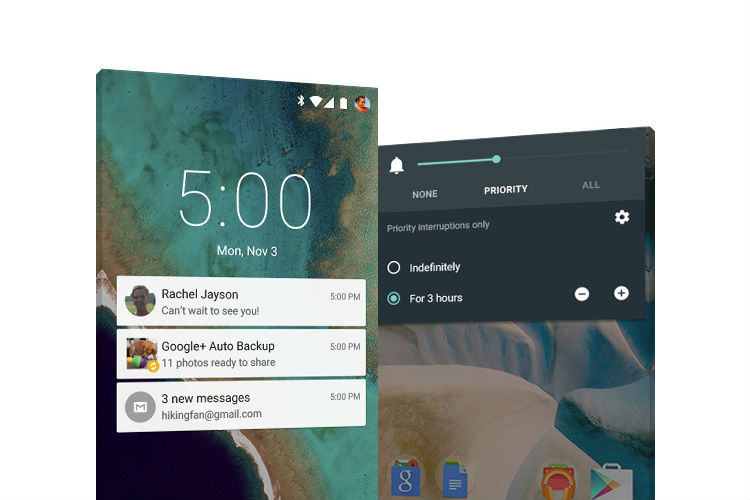The next sweeping overhaul of Android — Android 5.0 Lollipop — is rolling out starting Monday, Nov. 3. Here’s a look at some of its most notable additions, along with some insight as to when you might be able to get your hands on it.
What’s New?

The most noticeable difference is the overall look and feel of the operating system. Google’s using what it calls “Material Design,” making extensive use of animations and layered elements to deliver what the company promises is a more intuitive experience.
In layman’s terms, let’s just say there’s more swooping and sliding. And you’ll notice a more uniform design across Android devices in general — phones, tablets, watches, TV gadgets, car audio systems and more. If you have multiple Android gadgets, they’ll work together more harmoniously than before.
You can see a bit of how Material Design looks up until about the 30-second mark of this video:
Battery life should be an improvement. Developers will be able to better fine-tune their apps so they don’t use as much juice, and there’s a new power-saving mode that lets you squeeze up to 90 extra minutes out of your phone if you can’t find an outlet. When you get around to charging your phone, it’ll tell you how long it’ll be until it’s at 100%.
Security gets beefed up as well, with encryption turned on by default to prevent data from being accessed on lost or stolen devices. (Authorities aren’t too happy about this.) Note that you can turn encryption on yourself if you’re running an earlier version of Android. Here’s how (follow up until the part about resetting your phone). For an extra layer of security, you’ll be able to unlock your phone or tablet only when it’s in proximity to your Android smartwatch.
There are also some cool new multi-user features, like being able to use a friend’s phone in guest mode. And if you log in with your Google credentials, you’ll be able to make calls and access your messages, photos and other data as though you were using your own phone.
Notifications also get a much-needed overhaul. They’ll now be ranked and presented based on priority. Ideally, messages from people you want to hear from will be most prominent, while some obscure app telling you it’s been updated won’t get as much screen time. You’ll be able to finesse how often you’re notified with a new “priority” mode that’ll only let certain people contact you or will let you turn off notifications altogether between certain hours.
On newer phones, you’ll enjoy fewer button presses. If the hardware supports it, you’ll be able to say “Okay, Google” to wake the phone up to help you search for something or set reminders without touching it. Some phones will simply wake up when you pick them up or double-tap the screen.
You can see a more complete list of features here; scroll down to the bottom and click the “See All Features” link.
When Can I Get It?
Google said Monday that Android 5.0 Lollipop has just started rolling out, but the exact time you’ll get it depends on your device and your carrier. Google’s “Nexus”-branded devices (Nexus 4, 5, 6, 7, 9 and 10) will have access to Android 5.0 sometime in November. Certain “Google Play edition” devices (the HTC One M8 and the Moto G, almost certainly) should see the update around the same time. The new Nexus 9 tablet is the only device with a firm date — November 3; the big-screen Nexus 6 smartphone is due “in stores in November,” says Google.
The official word is as follows:
Android 5.0 Lollipop, which comes on Nexus 6, Nexus 9 and Nexus Player, will also be available on Nexus 4, 5, 7, 10 and Google Play edition devices in the coming weeks.
After that, things get even murkier. Dan Graziano over at CNET has a roundup of moving-targets HTC, Samsung, Motorola, LG and Sony, so keep an eye on that post as it’s to be updated as things progress.
As for whether or not your device is eligible to get Android 5.0, there’s a loose 18-month window for certain Android devices. Google’s official word: “Devices may not receive the latest version of Android if they fall outside of the update window, traditionally around 18 months after a device release.” And that’s only for Nexus and Google Play devices; check with your carrier to see if they can shed any light on your situation. If you’ve had your phone for more than a year, you might be on the fence depending when the phone was initially released.
More Must-Reads from TIME
- Why Biden Dropped Out
- Ukraine’s Plan to Survive Trump
- The Rise of a New Kind of Parenting Guru
- The Chaos and Commotion of the RNC in Photos
- Why We All Have a Stake in Twisters’ Success
- 8 Eating Habits That Actually Improve Your Sleep
- Welcome to the Noah Lyles Olympics
- Get Our Paris Olympics Newsletter in Your Inbox
Contact us at letters@time.com